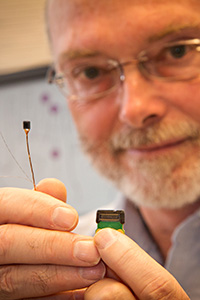
University of Utah researchers have received $1.4 million to further develop an implantable neural interface that will allow an amputee to move an advanced prosthetic hand with just his or her thoughts. The neural interface will also convey feelings of touch and movement.
Called the Utah Slanted Electrode Array, the neural interface uses 100 electrodes that connect with nerves in an amputee’s arm to read signals from the brain telling the hand how to move. Likewise, the neural interface delivers meaningful sensations of touch and movement from a prosthetic hand back to the brain.
“Imagine wiretapping into those nerves, which are like a hotline between the brain and the body,” said U bioengineering associate professor Gregory Clark, who is leading the research team involving neuroengineers, material scientists, electrical and computer engineers, surgeons and rehabilitation specialists. “We can pick up the nerve signals, translate them, and relay them to an artificial hand. People wouldn’t have to do anything differently from what they’d already learned how to do their whole life with their real hand. They’ll just think what they normally think, and the prosthetic hand will move.”
The Utah Slanted Electrode Array was first developed by University of Utah bioengineering professor emeritus Richard Normann and ultimately will communicate with the prosthetic limb wirelessly. The U will not develop the prosthetic hand or the wireless electronics. The wireless technology will be developed by local company and U collaborator, Ripple, LLC, in Salt Lake City, and the electrodes for the array are being manufactured by Blackrock Microsystems in the U’s Research Park.
The funding from the Defense Advanced Research Projects Agency (DARPA) will cover about 18 months of research and pay for testing on two human volunteers. The Utah team is eligible to receive up to $4.4 million from DARPA over the next five years.
Read this full press release in the U News Center
An amputee moves a virtual prosthetic limb on a computer monitor thanks to research from a University of Utah team that is working on the HAPTIX project.